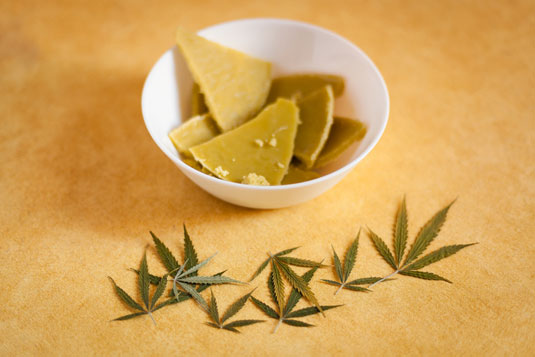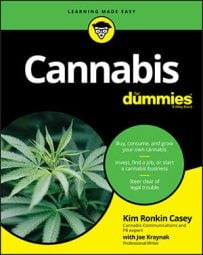How to calculate infusion doses
Creating infusions that contain a specific amount of THC, CBD, or other cannabinoids is challenging and may be nearly impossible to do if you’ve grown your own cannabis, because potency varies based on the plant strain, how it’s grown, dried, and cured, and other variables.However, if you start with flower from a reputable dispensary, it should be labeled with the weight of the product (in grams) and the concentration of each cannabinoid (as a percentage).
Using those two numbers, you can make your own cannabis-infused butter (such as Buddha Budda) and have a pretty clear idea of how much of each cannabinoid is in the entire batch. You just have to do the math:
- Multiply the number of grams of flower by 1,000 to determine the number of milligrams. 1 gram of flower is 1,000 milligrams; 2 grams of flower is 2,000 milligrams, and so on.
- Multiply the number of milligrams of flower by the percentage of a specific cannabinoid in the flower. For example, if you have 2,000 milligrams of flower with 15 percent THC, you have 2,000 mg ×15 = 300 mg THC.
More basic math is required to determine the total amount of a cannabinoid in an entire batch of a recipe:
- Divide the quantity of infused product called for in the recipe by the total quantity of infused product you made to find the percentage of infused product you used. For example, if a recipe calls for 4 tablespoons (Tbsp) of infused butter, and you made one stick of infused butter, 4 Tbsp / 8 Tbsp (the number of tablespoons in an entire stick) = 1/2 or 50 percent.
- Multiply the result from Step 1 by the total amount of cannabinoid in the entire stick to find out the total amount of cannabinoid in the recipe. For example, if the stick of cannabis-infused butter contains 300 mg THC, then half the stick contains 150 mg.
If you don’t have specifics regarding the amount of THC in the flower you have, look up the strain online and see if you can find any information about it. Seed catalogues list the percentage of various cannabinoids in each strain, which can provide you with a ballpark figure. Not knowing other variables, the number may not be very helpful, though.
Following are recipes for infused butter, sugar, and lavender syrup.Buddha Budda
Source: Sweet Mary Jane: 75 Delicious Cannabis-Infused High-End Desserts, a 2015 Random House title (978-1583335659)Buddha Budda is cannabis-infused butter. You can spread it on toast or muffins, melt it on waffles or pancakes, or use it to substitute for butter in any of your favorite recipes.

© By Moha El-Jaw/Shutterstock.com
When you’re creating your own extracts or concentrates, the potency of the finished product varies depending on the amount of flower you use and its potency. Some plant strains have higher concentrations of CBD, THC, and other cannabinoids than other plants do. This recipe includes three different versions, so you can gauge the potency to match your own needs and desires.
Yield: 1/2 cup (8 Tbsp or 1 stick) of Buddha Budda.THC concentration: Varies based on strain, amount, and potency of flower
Ingredients
1/2 cup (8 Tbsp or 1 stick) unsalted butter
1.5–6 grams cannabis buds, ground or finely crushed
Level 1
1.5 grams cannabis buds, ground or finely crushedYield: about 150 mg THC total
1 Tbsp = about 18.75 mg THC
12 edibles: about 12.5 mg THC each
18 edibles: about 8.3 mg THC each
Level 2
3 grams cannabis buds, ground or finely crushedYield: about 300 mg THC total
1 Tbsp = about 37.5 mg THC
12 edibles: about 25 mg THC each
18 edibles: about 16.6 mg THC each
Level 3
6 grams cannabis buds, ground or finely crushedYield: about 600 mg THC total
1 Tbsp = about 75 mg THC
12 edibles: about 50 mg THC total
18 edibles: about 33.3 mg THC total
Infusion equipment
Digital temperature gun (It’s the only way to test the temperature of the weed.)
Decent digital scale that weighs both grams and oz
Paint-straining bags or cheesecloth
Large bowl
Strainer
Rubber gloves
Directions
- Decarboxylate the cannabis: Preheat the oven to 250°F. Place the cannabis in a small, heat proof baking dish and place in the oven. After 15–20 minutes, check the temperature of the cannabis with your digital temperature gun; once it has reached 250°F, let it bake for 30 minutes, checking the temperature frequently. (In addition to decarboxylating, you’re removing any moisture left in the plant material.) If it goes over the correct temperature for too long, it will burn, the THC may convert into CBN, and you will lose potency. Remove from the oven and set aside to cool. If not using immediately, store the cannabis in an airtight container in a dark place for up to two months.
- Melt the butter in a small saucepan over medium-low heat. Add the decarbed weed and bring the temperature of the butter up to 190°F. Cook for 30 minutes, using the digital temperature gun to check the temperature of the butter frequently and make sure it does not go over 200°F. DO NOT LEAVE UNATTENDED! (If by chance it does go over 200°F for a few minutes, don’t worry, it isn’t ruined. The THC is still in there. But excessive heating causes degradation of THC and may convert it to CBN, one of the cannabinoids responsible for the sedative effects of cannabis, or result in vaporization of the compounds. Inadequate heating isn’t good either, as it causes the majority of the cannabinoids to remain in their acid form and thus unactivated. The density of the product, and the time and temperature of the oven, can also prevent some conversion, which results in unactivated cannabinoids. Adding the decarbed cannabis to the butter or coconut oil and heating it again ensures a better conversation.) Mostly, you want to keep everything at a simmer, not a boil. Just turn down the heat and watch it.
- Take the saucepan off the heat and let it sit for 10 minutes.
- It’s now time to press. Place a strainer over a large bowl. Place a paint strainer or cheesecloth into the strainer, folding down the sides over the outside. Spoon the infused butter into it. Using a large spoon or potato masher, press as much as you can through the cloth. Then, using your hands (rubber gloves help here!), squeeze the bag. Press out as much of the precious liquid as you can. Measure the amount of liquid (infused butter) remaining. Expect a 25 percent loss; this is not a loss of THC, only of butter. Make up the difference with regular melted butter.
Hey, Sugar!
Source: Sweet Mary Jane: 75 Delicious Cannabis-Infused High-End Desserts, a 2015 Random House title (978-1583335659)At Sweet Mary Jane, for the first few years we infused all our baked goods with Buddha Budda or Coconut Bliss. But, eventually, I wanted to try another technique. After some experimenting, I came up with the Idea of infusing sugar. It turned out to be a genuine innovation. The beauty of infused sugar is that there is much less cannabis flavor and color in the finished product. Many of the confections we sell use Hey Sugar!. We also sell packages of it for people to use to sweeten their coffee or tea, or to bake with at home.
Use the highest-proof alcohol you can find. If you have access to Everclear, use that. Otherwise, Bacardi 151 rum will do the trick (if not quite as well).
Hey Sugar! can be dropped into any hot drink. If you want to add it to a cold drink, heat a small portion of liquid, add the Hey Sugar!, stir to dissolve, and then add it to your drink. It can also be substituted for sugar in any of your favorite recipes.
As you will see in the following recipes, the amount of bud used determines the level of THC in the finished desserts, with three levels of dosing.
Yield for each of the following recipes is 1/4 cup of Hey Sugar!
Ingredients
1.5–6 grams cannabis bud, ground or finely crushed (amount varies depending on potency desired, see below)
1/4 cup granulated sugar
high-proof alcohol (Everclear works best, but not every state sells it; if you can’t purchase it, use Bacardi 151 rum)
Level 1
1.5 grams cannabis bud, ground or finely crushedYield: about 150 mg THC total
1 tsp = about 12.5 mg THC
Level 2
3 grams cannabis buds, ground or finely crushedYield: about 300 mg THC total
1 tsp = about 25 mg THC
Level 3
6 grams cannabis buds, ground or finely crushedYield: about 600 mg THC total
1 Tsp = about 50 mg THC
Infusion equipment
Digital temperature gun (It’s the only way to test the temperature of the weed.)
Decent digital scale that weighs both grams and oz
2 mason jars
Funnel
Coffee filter
Small heat-proof baking dish
Heat-proof glass pie dish
Directions
- Decarboxylate the cannabis: Preheat the oven to 250°F. Put the cannabis in a small, heat-proof baking dish and place in the oven. After 15–20 minutes, check the temperature of the cannabis with your digital temperature gun; once it has reached 250°F, let it bake for 30 minutes, checking the temperature frequently. (In addition to decarboxylating, you’re removing any moisture left in the plant material.) If it goes over the correct temperature for too long, it will burn, the THC may convert into CBN, and you will lose potency. If not using immediately, store the cannabis in an airtight container in a dark place for up to two months.
- Remove the baking dish from the oven and reduce the oven temperature to 200°F.
- Transfer the cannabis to a mason jar. Pour in just enough alcohol to cover it, and seal the jar. Shake the jar every 3–5 minutes for 20 minutes, then open the lid.
- Line a strainer with a coffee filter and place it over a bowl. Pour the alcohol solution through the coffee filter to strain off the plant matter. Gently press with the back of a spoon or your fingertips, being careful not to break the filter.
- Place the sugar in a heat-proof glass pie dish. Add the strained alcohol solution to the sugar and bake for 30 to 60 minutes, stirring well every 10 minutes, until all the liquid has evaporated and the sugar is evenly colored. (The color can range from light to dark amber.)
- Store in an airtight container in a cool, dark place. There is no need to refrigerate. Hey Sugar! Is good for one year.
Infused Lavender Simple Syrup
Source: Maxwell Bradford, Native RootsServing size should be based on desired THC content.
Ingredients
3 grams dried lavender
3 cups water
2 cups cannabis-infused sugar (See the earlier recipe for infused sugar.)
Directions
- In a small saucepan bring water to a boil.
- Stir in dried lavender.
- Simmer until fragrant and remove from heat.
- Strain out all residual lavender using cheese cloth or a coffee filter.
- Bring the now purple filtered lavender water back to a rolling boil.
- Add infused sugar and continue to boil until all sugar granules have dissolved.
- Remove from heat and let cool.

